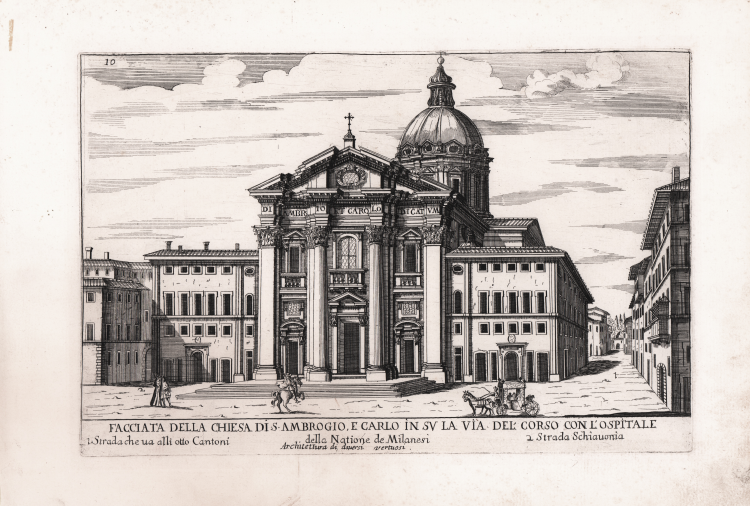



| Reference: | s34705 |
| Author | Giuseppe Tiburzio Vergelli |
| Year: | 1686 ca. |
| Zone: | Via del Corso |
| Printed: | Rome |
| Measures: | 296 x 197 mm |


| Reference: | s34705 |
| Author | Giuseppe Tiburzio Vergelli |
| Year: | 1686 ca. |
| Zone: | Via del Corso |
| Printed: | Rome |
| Measures: | 296 x 197 mm |
Plate taken from Il nuovo splendore delle fabriche in prospettiva di Roma moderna : fatte restaurare dalla fel. mem. di Papa Alessandro VII : nuouamente intagliato sotto il felice pontificato di N.S. Papa Innocentio XI copiate dalle stampe di gia intagliate da Gio. Batt. Falda da Valdugia; da Matteo Gregorio Rossi, Romano ... [Matteo Gregorio Rossi] in Piazza Nauona all' insegna della Stampa, the year 1686 [-1688], published in 3 volumes between 1686-1688, by Matteo Gregorio de Rossi.
After the incredible success of Il nuovo teatro delle fabriche, et edificii, in prospettiva di Roma moderna. Libro primo (secondo, terzo) a work in 3 volumes, with engravings by Giovanni Battista Falda, published by Gian Giacomo de Rossi of the Tipografia alla Pace, between 1665 and 1669, the De Rossi printing house in Piazza Navona, directed at the time by Matteo Gregorio, attempted a commercial operation that was then widespread: to publish a similar work that could compete with that of Falda.
Thus were born the 3 volumes of Il nuovo splendore, published between 1686 and 1688, with engravings made by Giuseppe Tiburzio Vergelli copying those of Falda, or imitating the style in those of his original creation. The work is dedicated to Urbano Barberini, prince of Palestrina; the title openly declares the source of the plates: copiate dalle stampe di gia intagliate da Gio. Batt. Falda da Valdugia. A fourth volume containing the fountains of Rome, again copied by Falda, came out in 1690 with the title Le fontane pubbliche delle piazze di Roma disegnate da Gioseppe Triburno Vergelli relanatese intagliate da Pietro Paolo Girelli Romano.
Matteo Gregorio De Rossi is an exponent of one of the branches of the famous Roman printing house. Towards the end of the sixteenth century began the editorial activity of Antonio De Rossi, who with his sons Giuseppe the Elder and Giulio, founded the printing house that, over the next two centuries and through four generations, held the monopoly of chalcographic production in the city. The workshop had the sign “De Rossi alla Pace”. The history of the De Rossi family is characterized by internal disputes and contrasts that lead to the opening of individual printing houses in competition with each other. Giulio De Rossi's sons, Giuseppe the Younger and Giovanni Battista, nephews of Giuseppe De Rossi the Elder, had founded in 1628 their own workshop in the vicinity - at the corner of Via di Parione and Via della Pace near the church of S. Biagio della Fossa - but in 1635 Giovanni Battista in turn separated from his brother and opened a workshop in Piazza Navona, the third of the family. In 1644, after the death of Giuseppe the Younger, his brother Giovanni Battista became the most direct competitor of his uncle's workshop, the De Rossi alla Pace, now run by his widow along with their children who were then partly still minors. Giovanni Battista's son, Matteo Gregorio De Rossi, continued his father's publishing activity, dedicating himself with success also to the activity of engraver. The main collaborator of the typography of Giovanni Battista and Matteo Gregorio was a great artist of the caliber of Lievin Cruyl, who used the typography for the translation into print of many of his drawings on Rome.
Etching, printed on contemporary laid paper, with margins, in excellent condition.
|
Rossetti 11301. Kissner 454.
|
Giuseppe Tiburzio Vergelli (Recanati, 1629 – 1700 circa)
|
Giuseppe Tiburzio Vergelli was born in Recanati on October 12, 1629 to the sculptor Tiburzio and Lucrezia Botani. Trained as an architect, in the years 1658-77 in Loreto he was in charge of the buildings of the Holy House, also designing some towers along the Romagna coast, perhaps those wanted by Clement X in 1673 to defend against Turkish incursions. In Rome, over the course of 22 years, he worked on perspective and architecture, overseeing the construction of some noble residences. Among other activities he gave to the presses Le due regole della prospettiva pratica del Vignola, con i commentarii del rever. p. maestro Egnatio Danti [...] epilogate da Giuseppe Tiburtio Vergelli [...] (Roma, per il Mascardi, 1682), in compendio, and Le fontane pubbliche delle piazze di Roma moderna disegnate da Gioseppe T. V. recanatese. Returning to his hometown, he was appointed public depositary of Recanati in August 1695. His date of death is unknown.
|
|
Rossetti 11301. Kissner 454.
|
Giuseppe Tiburzio Vergelli (Recanati, 1629 – 1700 circa)
|
Giuseppe Tiburzio Vergelli was born in Recanati on October 12, 1629 to the sculptor Tiburzio and Lucrezia Botani. Trained as an architect, in the years 1658-77 in Loreto he was in charge of the buildings of the Holy House, also designing some towers along the Romagna coast, perhaps those wanted by Clement X in 1673 to defend against Turkish incursions. In Rome, over the course of 22 years, he worked on perspective and architecture, overseeing the construction of some noble residences. Among other activities he gave to the presses Le due regole della prospettiva pratica del Vignola, con i commentarii del rever. p. maestro Egnatio Danti [...] epilogate da Giuseppe Tiburtio Vergelli [...] (Roma, per il Mascardi, 1682), in compendio, and Le fontane pubbliche delle piazze di Roma moderna disegnate da Gioseppe T. V. recanatese. Returning to his hometown, he was appointed public depositary of Recanati in August 1695. His date of death is unknown.
|